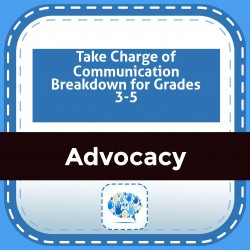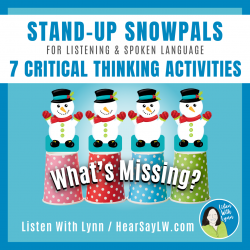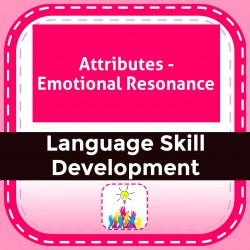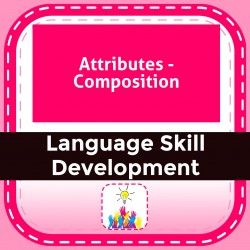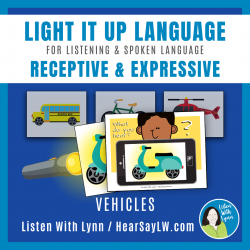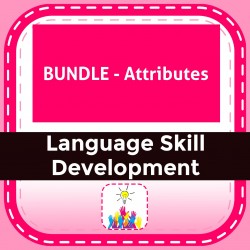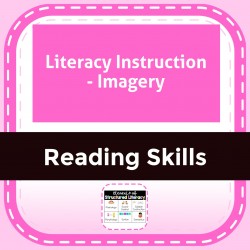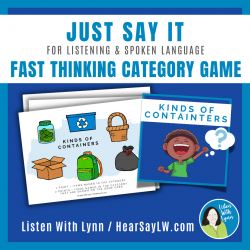Ability Levels
Categories
Resource Types
Age/Grade Range
CCSS
Anchor Standard
Speaking & Listening
Language
Reading
Take Charge of Communication Breakdown for Grades 3-5
$ 8
A ten-page comic-style book (in color & grayscale) defines communication and communication breakdown. Examples are shown as interactions between two boys: Luke and Ricardo. A teacher acts as narrator
...
and discusses three tools for repairing communication breakdown: signaling the breakdown, asking for repetition and repeating what was heard. The boys use each tool in responding to a single CBd event. A glossary is provided at the end of the book. Materials also include a graphic organizer, 8 discussion-starter cards, 6 review cards and 5 comprehension questions for assessment. Teacher notes explain how the lesson materials can be used in face-to-face lesson or on a digital platform.
Critical Thinking For Listening and Language Winter Snowpals
$ 5
Kids love playing “WHAT’S MISSING?” games as they learn to think critically, develop listening, and memory skills while building receptive and expressive language.The Stand-Up Snowpal resource include
...
urce includes SEVEN interactive activities for preschoolers through elementary children. Stress-free ways for practicing and building communication skills with the kids you see at school or for therapy. FUN for the kids and SIMPLE for you! Quick and easy one-time print and cut the Snowpals.Use all winter and year after year.TARGETS:Kids use their existing knowledge, experiences, and problem-solving skills for✤ Critical thinking✤ Communication✤ Auditory and visual memory✤ Compare and contrast✤ Part to whole relationships✤ Cause and effect✤ ObservationsINCLUDES:Seven activities or ways to playDeck of sixteen Snowpal cardsEight colorful stand-up SnowpalsInstruction guideListening and Spoken Language TipsYou’ll need 8 papers cups◈ ◈ ◈ ◈ ◈ ◈ ◈ ◈ ◈ ◈ ◈ ◈ ◈ ◈ ◈ ◈ ◈ ◈ ◈ ◈ ◈ ◈ ◈ ◈ ◈ ◈ ◈ ◈ ◈ ◈ CUSTOMER TIPS:➼ Questions? Email me before purchasing this resource or anytime later.➼ Follow me to be updated with newbies and freebies!♥ Sign-up HERE for the Listen With Lynn Newsletter♥ Let’s Connect:InstagramFacebookKeep up your good work. I am blessed to help along the way. Thanks so much!Lynn
Attributes - Emotional Resonance
$ 295
When telling a story, a speaker/writer must delineate the surface action through the plot and connect the plot to the protagonist to develop a deeper understanding of the meaning and purpose of the st
...
ory. Using words that convey emotion does exactly this. Use these activites and worksheets to help students understand emotion words. Activities include classfiying, matching, writing, comparison, feelings rating scale, and a template for Five Senses Poem.
Attributes - Composition
$ 295
These activities and worksheets discuss the simple and complex attribute of composition and classification. Students will develop awareness of the concept, classify objects based on group, function,
...
parts, shape, size, association, and location. Includes cut and paste classifying activity, learning parts of a car, choosing the best words to describe, and fill in the blank.
VEHICLES Auditory Processing Receptive & Expressive Language
$ 5
You'll love the VEHICLES version of Light It Up Language! Kids listen to clues to identify 16 hidden VEHICLES vocabulary pictures. Each of the pictures has four clues that are increasingly more specif
...
pecific.The magic happens by lighting up the “What Do You Hear?” cards. Hidden pictures are held up to a flashlight and the VEHICLES images amazingly appear. How fun! Once the hidden picture is revealed the child recalls and uses the clues to describe the VEHICLES. Thereby stretching their auditory memory, descriptive language, and expressive language skills.TARGETS: RECEPTIVE: This game builds critical thinking and reasoning skills by categorizing, making inferences, and drawing conclusions. EXPRESSIVE: The child recalls and uses clues to describe the hidden object. INCLUDES:✧ Listening & language guide with instructions✧ Target or goal suggestions✧ 8 What Do You Hear? cards (printed twice)✧ 16 Hidden ANIMALS Picture Vocabulary Cards✧ 64 Prompt Clues - 16 objects with four details each that get increasingly more specific✧ A Script with scaffolding strategies✧ Listening and Spoken Language Tips ➼ EASY one-time quick game prep and you're all set to use year after year. ➼ You’ll need a FLASHLIGHT, a lamp, or a sunny window.◈ ◈ ◈ ◈ ◈ ◈ ◈ ◈ ◈ ◈ ◈ ◈ ◈ ◈ ◈ ◈ ◈ ◈ ◈ ◈ ◈ CUSTOMER TIPS:➼ Questions? Please email me before purchasing this resource or anytime later.♥ Sign-up HERE for the Listen With Lynn emails♥ For more ideas visit my blog: HearSayLW.comSTAY CONNECTED:✧ Sign-up here for the Listen With Lynn emails✧ Follow on Facebook - Lynn A. Wood - LSL Auditory Verbal Therapist and Rehab Audiologist✧ Follow on Instagram @auditoryverbal_listenwithlynn❤ Keep up your excellent work. I am blessed to help along the way. Thanks so much!Lynn Wood
BUNDLE - Attributes
$ 795
This instructional bundle contains 7 worksheet packets and the CALI assessment for student attribute knowledge. Topics are: Introduction (0881), color (0882), composition (0883), decription (0884), em
...
otions (0885), size words (0886), temperature (0887), time (0888), and review (0889). Includes CALI assessment (0777).
Literacy Instruction - Imagery
$ 195
Imagery is the creation of a representation of an idea or concept in the mind. These instructional strategies include ways to improve reading comprehension by using vocabulary knowledge and learning
...
to create mental images.
SPRING DOGS Listening Critical Elements Directions Descriptions
$ 7
SPRING DOGS is an engaging following-direction springtime game with critical elements that get kids listening and engaged. Kids love the delightful dogs that challenge auditory working memory, compreh
...
prehension, and auditory processing speed. The game uses descriptions that boost critical thinking, executive functioning, and communication skills.SPRING DOGS is a flexible game where you can play using all the cards, sort out a smaller set, or simplify the directions. It is easy to level up or down the directions to meet a child’s needs and goals.SPRING DOGS is effective for all children and outstanding for kids who are deaf and hard of hearing and who struggle to recall longer sentences or remember only part of the information that was said. A child’s capacity to listen, remember, and recall impacts their ability to follow complex instructions, understand detailed conversations, and learn new information.INCLUDES:✤ A Huge Resource of 78 playing cards✤ 36 Spring Dog picture cards✤ 36 description/direction cards✤ Six Game Mats✤ A set of PRINTABLE game cards✤ A DIGITAL game board✤ Data Collection Sheet✤ A Guide with instructions ✤ Listening and Spoken Language TipsIDEAL FOR: Listening and spoken Language, Deaf and hard of Hearing, Auditory Processing Disorder, Speech and Language Therapy, School Lessons, Auditory Verbal Sessions, Homeschoolers, TeletherapyFACE TO FACE - TELETHERAPY - HOME✢ PRINT - One-time easy prep. Print and cut out the Spring Dog picture cards and the description/direction cards, and print the six game mats✢ DIGITAL - Screenshare the gameboard with your favorite PDF reader such as the free Adobe Acrobat Reader DC. Read the descriptions, and the listener marks the dogs using the annotation tools.◈ ◈ ◈ ◈ ◈ ◈ ◈ ◈ ◈ ◈ ◈ ◈ ◈ ◈ ◈ ◈ ◈ ◈ ◈ ◈ ◈ ◈ ◈ ◈CUSTOMER TIPS❤ ‼️ Sign-up HERE for the Listen With Lynn Emails➼ Questions? Please Email me before purchasing this resource or anytime later.❤ Let’s Connect:InstagramFacebookKeep up your good work. I am blessed to help along the way. Thanks so much!Lynn Woo
Vocabulary and Category Fast Thinking JUST SAY IT! Game
$ 5
JUST SAY IT is a no-prep, fast-paced competitive game where kids score points and build classification skills, vocabulary, and auditory memory. Learning new vocabulary by categories can result in impr
...
oved comprehension and retention. JUST SAY IT is easily leveled up or down to meet a variety of children's goals. Kids ask to play the game over and over again. It's a must for your listening and language toolbox.You can target :Just Say It! encourages listening, concentration, and attention skillsteaches classification skills and critical thinking skillsbuilds vocabulary and word recallencourages verbal expression expands auditory memory and recallfosters cooperation, turn-taking, and social skillsWhat's included:32 category prompt cards32 cue-to-listen cards designed to build ear contact before eye contact, which is critical to growing a child’s brain for auditory skills.Listening and Spoken Language TipsJust Say It! can be easily leveled up or down to meet a variety of children's goalsExamples: Things that are roundThings in a kitchenAnimals that swimSchool suppliesThings made of metalKinds of containers➼ DIGITAL - NO PRINT can be opened and played with your favorite PDF reader app on a tablet. When playing on a computer, open and use a PDF reader such as Adobe Acrobat Reader DC which is free. ➼ PRINT - Print the game cards➼ PLEASE NOTE: Just Say It! can also be found in my Listen With Lynn™ Boom Learning Store. To use BOOM CARDS, you must be connected to the Internet.◈ ◈ ◈ ◈ ◈ ◈ ◈ ◈ ◈ ◈ ◈ ◈ ◈ ◈ ◈ ◈ ◈ ◈ ◈ ◈ ◈ ◈ ◈ ◈ ◈ ◈ ◈ ◈ ◈ ◈ CUSTOMER TIPS:➼ Questions? Email me before purchasing this resource or anytime later.♥ Sign-up HERE for the Listen With Lynn Newsletter♥ Let’s Connect:InstagramFacebookKeep up your good work. I am blessed to help along the way. Thanks so much!Lynn
Attributes - Hot and Cold
$ 295
Awareness of how a speaker or author uses weather and temperature to express and symbolize emotion and mood supports comprehension and visualization. It helps connect the listener/reader to the conten
...
t. Use these activities to help students understand how to use temperature words to convey mood and meaning. Activities include recognizing symbolism, temperature similes, expressing feelings using temperature words, matching, creating similes, text evidence, and critical thinking.
 Your browser is out of date. For best experience switch to latest updated Browser.
Your browser is out of date. For best experience switch to latest updated Browser.
 Get Chrome
Get Chrome Get Edge
Get Edge Get Firefox
Get Firefox